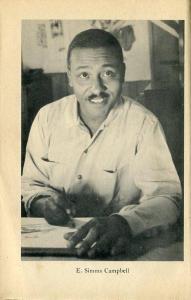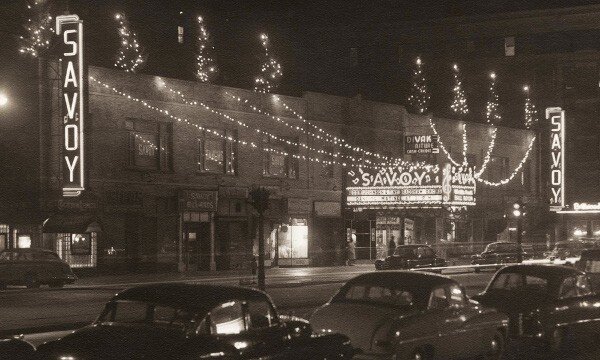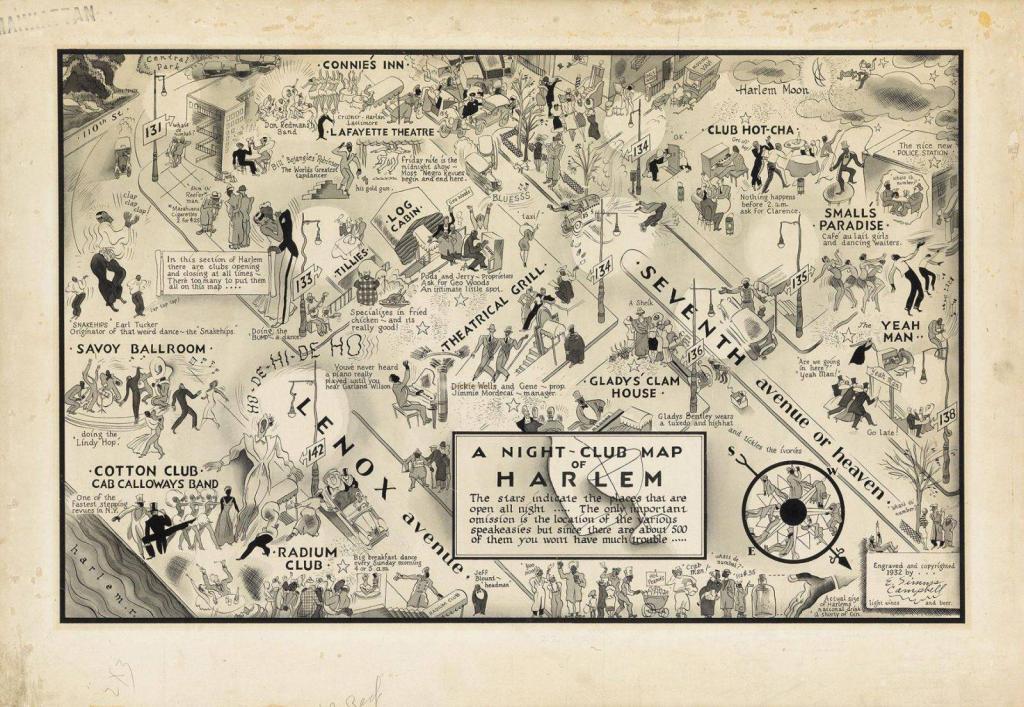The Map
In 1932, E. Simms Campbell, considered the first commercially-successful African-American illustrator, created a map of a two-block area of Harlem between Lenox Avenue and 7th Avenue showing the location of a dozen jazz venues that were the center of Harlem nightlife. Campbell made the map for a short-lived magazine called Manhattan, a publication that was similar in content to Esquire.
The cartoon appeared during a time known as the Harlem Renaissance that has been described as “a flowering of African-American literature, theater, and music during the 1920s and early 1930s.” The map is filled with caricatures of famous musicians and dubious denizens of the nighttime scene as well as helpful tips for partygoers.
Ample Liquid Libations
While Prohibition would come to an end in another year, it is obvious that alcohol was readily available throughout the area between Lenox and 7th Avenues and bounded by 133rd Street and the northern edge of Central Park. As legend states, “The only important omission to the map is the location of various speakeasies, but since there are 500 of them, you won’t have much trouble finding one.
The map reveals that other intoxicants were also easily obtainable as depicted by a hunched figure shown near the corner of Lenox and 131st Street selling “marihuana” cigarettes (two for 25 cents) and proclaiming “Ah’m the reefer man.”

Descriptive Annotations
Along with identifying the location of the various nightspots, each club’s name is accompanied with a pithy comment, such as “The Radium Club has a big breakfast dance every Sunday morning at 4 or 5am.”
At the Club Hot-Cha, “Nothing happens before 2 am. Ask for Clarence.”
Tillie’s specializes in fried chicken . . . “and it’s really good!”
The next-door Log Cabin is “an intimate little spot, especially if you know to ask for George Woods.”
If you go to the Yeah Man, “go late.”
“You’ve never heard a piano played until you hear Garland Wilson at the Theatrical Grill,” which is located near Glady’s Clam House where “Glady Bentley wears a tuxedo and high hat and tickles the ivories.”
At the Lafayette Theatre, you can catch a show with Bill “Bojangles” Robinson, billed as “the world’s greatest tap dancer.”
The Savoy Ballroom
The Savoy Ballroom was the home of the Lindy Hop and also where Earl Tucker launched another dance craze, the Snakehips. The Ballroom, on the second floor of a building that ran a block long, measured 10,000 square feet and could hold 4,000 people. The dance floor had to be replaced every three years because of its constant use. The Ballroom had a double bandstand, so the music was always continuous.
The Savoy always had a non-discrimination policy. Frankie Manning said people were only judged on their dancing skills and not on the color of their skin. One night, a man shouted, “Hey man, Clark Gable just walked in the house,” to which his companion responded, “Oh, yeah, can he dance?” “Harlem’s most beautiful women” acted as hostesses to teach people to dance and were dance partners for anyone who purchased a 25 cent dance ticket. No man was allowed in the hall if he wasn’t dressed in a jacket and tie.
The Savoy was the site of many famous “Battles of the Bands” involving the top bands of the day. Chick Webb led the best-known house band during the mid-1930s that won a match-up over the Benny Goodman Orchestra in a 1937 “cutting contest.” The Ballroom was shut down in 1943 as a result of charges of vice by the Police Department and Army and permanently closed in 1958.
The Cotton Club
Cab Calloway, Duke Ellington, Ethel Waters, and Clayton “Peg Leg” Bates were among the many stars who performed at the Cotton Club. Though the acts were performed by African-Americans, whites were the only ones originally admitted to the Club as guests. Duke Ellington eventually persuaded the owners to allow African-Americans to be admitted, and they would fill up the seats in the back of the room. In its heyday, the Cotton Club served as a hip meeting spot with regular Celebrity Nights in Sunday that would attract Al Jolson, Jimmy Durante, Mae West, Eddie Cantor, Langston Hughes, and even New York City Mayor Jimmy Walker.
Small’s Paradise personified the excitement of Harlem nightlife during the Roaring ’20s with its elaborate floorshows, Charleston-dancing waiters (who brought Chinese food and bootleg liquor to the small tables), and an integrated audience.
Heiress Gertrude Vanderbilt and members of the Ziegfeld Follies were among those who frequented Connie’s Inn and were sometimes influential in moving the Harlem revues to Broadway.
The Alhambra and Apollo
Elsewhere in Harlem, the Alhambra Ballroom originally began as a theater with a capacity of 1,650 featuring vaudeville acts and movies. It opened an upstairs ballroom in 1926 hosting legendary performers Bessie Smith, Jelly Roll Morton, Frankie Manning, and a waitress named Billie Holiday.
The Apollo Theatre is one of Harlem’s most iconic and enduring cultural institutions. It was here in 1934 that Ella Fitzgerald had her first big break in winning an Amateur Night competition. The Apollo still operates as a theater and draws an estimated 1.3 million visitors annually.
“What’s the number?”
Throughout the map—even inside the police station—people are asking each other variations of “What’s the number?”, a reference to the numbers in illegal lotteries run by racketeers. The map is replete with much more detail and even hints at some darker themes along with poking fun at the New York City downtowners who journeyed up to Harlem in their fur coats to enjoy a night of hot jazz and bad booze in the clubs.
The Depression hit Harlem hard, and 50% of African-Americans were unemployed by 1932. A blind man with a cane is shown selling newspapers, and elsewhere, a moving van is being loaded, probably with the belongings of a family that had lost their home.
The original watercolor and ink drawing of Simms Campbell’s map is now part of the Collection of American Literature at Yale University’s Beinecke Library in New Haven, Connecticut. Simms went on to work for Esquire Magazine for 25 years, and his work also appeared in The New Yorker, Cosmopolitan, and Playboy.
This is the second of a series of articles on The Harlem Renaissance.
Lew Shaw started writing about music as the publicist for the famous Berkshire Music Barn in the 1960s. He joined the West Coast Rag in 1989 and has been a guiding light to this paper through the two name changes since then as we grew to become The Syncopated Times. 47 of his profiles of today's top musicians are collected in Jazz Beat: Notes on Classic Jazz.Volume two, Jazz Beat Encore: More Notes on Classic Jazz contains 43 more! Lew taps his extensive network of connections and friends throughout the traditional jazz world to bring us his Jazz Jottings column every month.





















